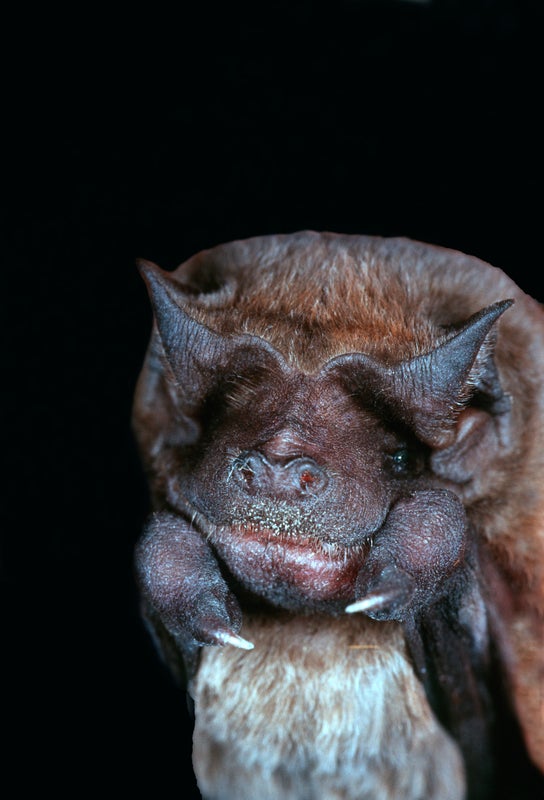(单词翻译:单击)
听力文本
This is Scientific American's 60-second Science, I'm JasonGoldman.
Each night, small groups of a species called velvety free-tailed bats emerge from their roosts in the Panamanian rain forests to hunt for their insect prey using echolocation.
"When bats are hunting, especially when they're in open areas, they produce two really distinct call types. So they have their 'search-phase' calls when they're just scanning the environment. And then they have 'feeding buzzes' when they actually detect prey, like an insect swarm."
Jenna Kohles, a graduate student at the Max Planck Institute of Animal Behavior in Germany.
Both types of calls are typically too high-pitched for us to hear. But other bats can eavesdrop on those feeding buzzes and use them as a cue for finding food. And it's always been assumed that the other calls, search-phase calls, don't include that kind of social information. But Kohles and her team wondered if search-phase calls might also be social and help bats stick together in the dark.
"This is why we then tested first whether these echolocation calls they produce when they're scanning the environment contain information about a bat's identity, like in the form of an individual signature. And then, more importantly, we wanted to test whether bats can actually use this information to discriminate between different individuals, just using these search-phase echolocation calls."

The researchers captured wild bats and exposed them to a particular call over and over again until they became bored and stopped reacting. Then the researchers played the same type of call but recorded from a different bat. If the bats reacted, it means that they noticed that the identity of the caller had changed.
And that's exactly what happened, which suggests that some kind of individual signature is encoded within search-phase calls. The results are in the journal Behavioral Ecology.
Many other animals that hunt in groups use vocalizations to keep connected. But bats already invest most of their vocal resources in echolocation for hunting. So it appears that these bats have figured out how to accomplish both tasks—hunting and coordination—using a single type of vocalization.
"Bats can use this in a social strategy to forage within hearing distance of particular individuals to potentially find food faster or to find food more predictably."
Kohles says that this finding offers a new way to think about the evolution of social communication in bats—and that we may be underestimating the role of relationships in bats' success at hunting.
Thanks for listening for Scientific American's 60-second Science. I'm Jason Goldman.
参考译文
这里是科学美国人——60秒科学系列,我是杰森·古德曼。
每天晚上,一小群天鹅绒无尾蝙蝠会从巴拿马雨林的栖息地出来,利用回声定位捕食昆虫。
“蝙蝠在捕食时,尤其是在开阔地带捕食时,会发出两种截然不同的叫声。如果它们只是在扫描环境,它们会发出‘搜索阶段’的叫声。而当它们真的发现昆虫群等猎物时,就会发出‘进食吱吱声’。”
德国马克斯·普朗克动物行为研究所的研究生詹娜·科尔斯说到。
对我们来说,这两种叫声的音高通常太高,所以人耳听不到。但是其它蝙蝠可以偷听到这些“进食吱吱声”,并以此作为寻找食物的线索。人们一直假设另一种叫声即“搜索阶段”叫声,不包括这种社交信息。但科尔及其团队想知道,“搜索阶段”叫声是否也具有社交性,是否能帮助蝙蝠在黑暗中团结在一起。
“所以我们后来先进行了测试,看看它们扫描环境时发出的回声定位叫声是否包含与蝙蝠身份有关的信息,比如个体签名形式的身份信息。更重要的是,我们想测试蝙蝠是否真能仅利用‘搜索阶段’回声定位叫声这种信息来来区分不同的个体。”
研究人员捕捉野生蝙蝠,让它们一遍又一遍地听一种特定叫声,直到它们感到厌烦并停止反应。之后研究人员播放另一种蝙蝠发出的同一种叫声。如果这些蝙蝠有反应,就意味着它们注意到鸣叫者的身份发生了变化。
而这确实发生了,这表明,个体签名编入了“搜索阶段”叫声中。这项研究结果发表在《行为生态学》期刊上。
其他许多成群捕猎的动物都用回声定位来保持联系。但蝙蝠已将大部分声音资源投入捕猎回声定位中。因此,这些蝙蝠似乎已找到完成狩猎和协调这两项任务的方式,那就是利用单独类型的回声定位。
“蝙蝠可以在社交策略中使用这种方法,在特定个体的听觉距离内觅食,以便更快地找到食物,或者更有预见性地找到食物。”
科尔斯表示,这一发现为思考蝙蝠社交沟通的进化提供了新方法,我们可能低估了社交关系在蝙蝠成功捕猎中的作用。
谢谢大家收听科学美国人——60秒科学。我是杰森·古德曼。
译文为可可英语翻译,未经授权请勿转载!
重点讲解
重点讲解:
1. emerge from (从隐蔽处或暗处)出现,浮现,露出;
The swimmer emerged from the lake.
游泳者从湖水中浮出来。
2. eavesdrop on 偷听;窃听;
The news was got through eavesdropping on the parents's conversation.
这消息是偷听父母谈话得来的。
3. stick together 团结一致;相互支持;
If we all stick together, we ought to be okay.
如果我们大家团结在一起,就不会有事。
4. over and over again 一再;再三;反复;
The police replayed footage of the accident over and over again.
警察一遍又一遍地重放事故的片段。


